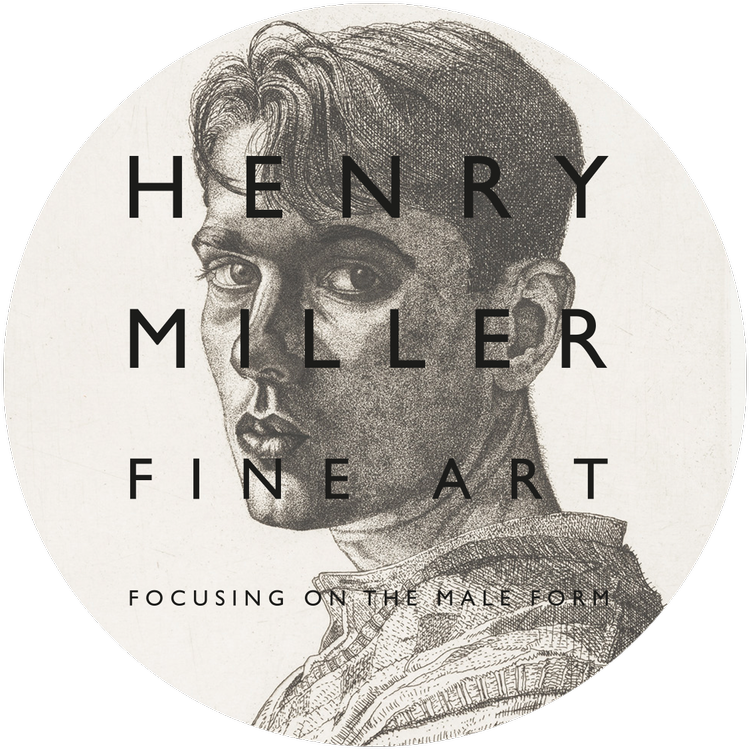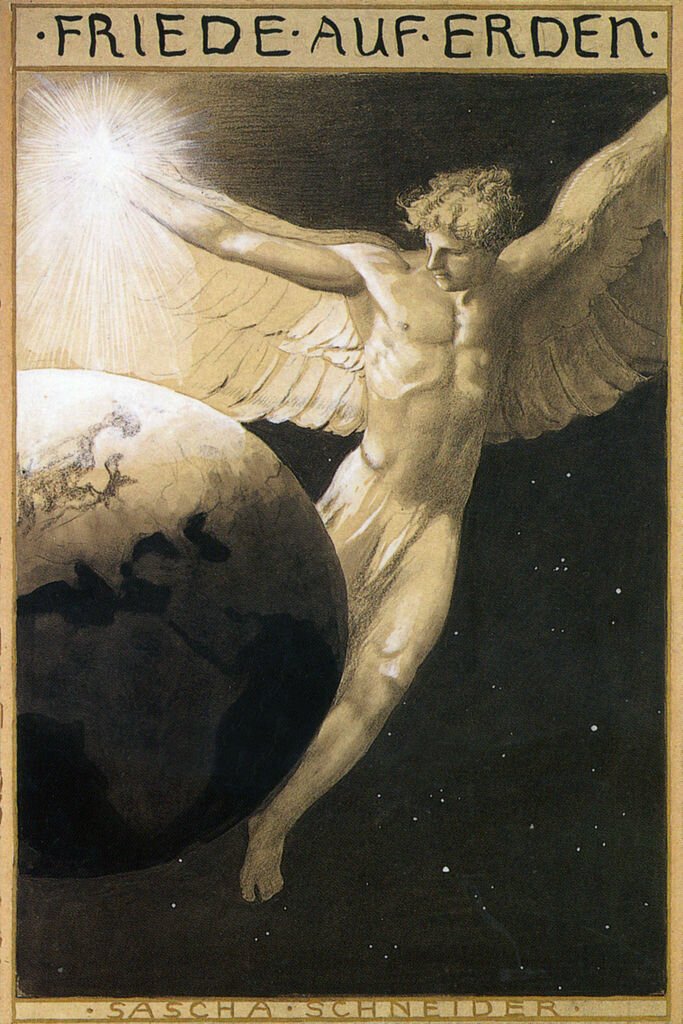(N.B. If you are reading this in your email feed, the piece reads better on the website. Just click the title and it will take you to the blog.)
Sascha Schneider in his studio in front of his painting “Um die Warheit’ (The Truth), c.1902
Born in Saint Petersburg in 1870, Sascha Schneider grew up in Zürich and moved to Dresden in 1889 where he studied at the Academy of Fine Arts. He started exhibiting in 1894 and opened his first studio in 1900 where he created works that optimised and glorified the male body as an object of desire, as depicted in his large scale masterpiece “The Truth” (Um Die Warheit) from 1902.
An enfant terrible of the German symbolist movement, his work rejected a realistic depiction of the natural world, in favour of imaginary dream worlds populated with mysterious figures from literature, the bible, and Greek mythology. What set him apart from other symbolist artists of the time was the overriding homoeroticism which permeated most of his work, perhaps explaining why, although highly successful, he never actually received proper recognition from the art establishment (one of his sculptures was rejected for “incitement to unnatural fornication”).
————————
images below: Der Anarchist, c.1896-1900, wood engraving on paper mounted on card, Henry Miller Fine Art; Das Gefühl der Abhängigkeit, (The Feeling of Dependence), c.1896-1900, wood engraving on paper mounted on card, Henry Miller Fine Art
In 1903, he met the best-selling author Karl May who commissioned Schneider to create a series of new book covers for his popular novels and travel stories. May was one of Germany’s most famous novelists, his Western adventures sold millions of copies and brought Schneider’s work to a vast audience. May knew of, and accepted, Schneider’s homosexuality and what started as a unique creative relationship and a visionary friendship between two artists, became the basis for the reinterpretation of May's novels as a complete work of art. The classically inspired works on the covers though bore hardly any relation to the content of May’s stories and at the end the publisher, unhappy with the ambivalent nature of these pictures, had them replaced in later editions. (These original books are still available through websites such as ebay, and are a great way into collecting his work.)
————————
images below; Karl May: Old Surehand, 1904; Karl May, Am Rio de la Plata, 1904; Karl May, Peace on Earth, 1904.
In 1904, Schneider was appointed professor at Weimar’s Grand Ducal Art School, a post previously offered to Gustav Klimt who had turned it down. As an artist, Schneider focused on the beauty of the male nude and while he never hid the fact that he was homosexual, he considered himself a social outsider – both as an artist and as a gay man (homosexuality was illegal in Germany at the time) and never fitted in within the local art scene.
At the time he lived with the painter Hellmuth Jahn. Jahn however subsequently blackmailed him, and threatened to expose his homosexuality. As a result in 1908, Schneider fled to Itlay where he started developing new ideas of how to change society through art. He lived in Florence until 1914 and moved back to Germany at the start of WW1.
————————
images below: Der Gram (The Grief), c.1896-1900, wood engraving on paper mounted on card, Henry Miller Fine Art; Mammon and his Slave, c.1896-1900, wood engraving on paper mounted on card, Henry Miller Fine Art.
In 1919 he founded the Kraft-Kunst Institut in Dresden. It was basically a gym with artistic aspirations in which Schneider’s sculptures and paintings could be displayed alongside exercise equipment, mirrors and actual body builders whom he used as models.
He regarded the beautiful naked male physique as art in its own right. The creation of the institute also corresponded with the emergence of a fresh approach towards the human body and new interpretations of physical beauty. Rooted in classical antiquity and working with the ideal image of man, his work was groundbreaking as it sought to conceptualise and celebrate homosexuality through art; something quite extraordinary 100 years ago.
The Kraft-Kunst Institut, Dresden, c.1920s.
As a sculptor Schneider didn’t want to limit himself to clay and bronze. He wanted to shape the human flesh itself by means of strength training and body building. He could see beauty (and art) in a well shaped musculature so he started working with real people, presenting his ‘ideal bodies’ on stage in a performance at the Dresden Albert Theatre that included choreographies with titles such as ‘Ancient Wrestling Matches’ and ‘Exercises and Games from Ancient Physical Culture’.
Sonnenanbeter (The Sun Worshipper), Schloss Eckberg, Dresden.
Sascha Schneider died in 1927. In recent years he has being rediscovered as one of the first openly gay artists, and a leading light in the health and body culture movement at the turn of the 20th century. In 2013, a major retropsective of his work was held at the Kunsthalle, Weimar, which then transferred to the Leslie Lohman Museum in New York. The exhibition catalogue, Sascha Schneider, Visualising Ideas Through the Human Body, is extremely good, if you are able to find one online.











